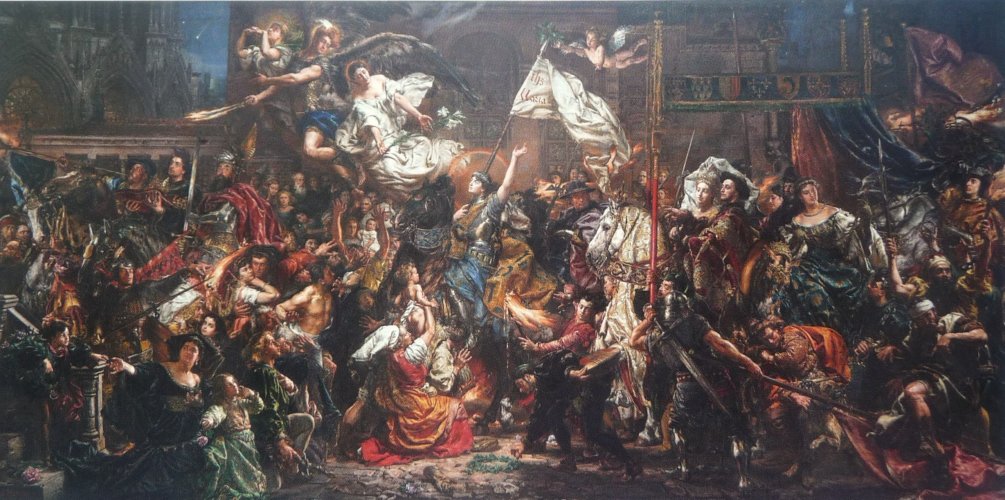Description:
Jan Matejko (1838-1893) studied at the School of Fine Arts in Krakow under Wojciech Kornel Stattler and Władysław Łuszczkiewicz, and then at the Munich Academy under Herman Anschütz. He debuted at the age of 16. He exhibited in Europe and America. He was a member of the Krakow Scientific Society, the Academy of Fine Arts in Krakow, the Academy of Fine Arts in Paris. In 1870 he was awarded the Legion of Honor. In 1869 he was declared an honorary citizen of the city of Lviv, in 1882 – Krakow. In 1873 he was appointed director of the School of Fine Arts in Krakow, and in 1874 he was appointed to the French and Berlin Academies of Art. In 1887 he was awarded an honorary doctorate from the Jagiellonian University. His work was honored with numerous awards and medals. Among them, the one made from public contributions, which he received in Krakow, as well as the “scepter of mastery in art” was of particular significance. He believed that art should serve the fatherland and nation. He was a historian-philosopher influenced by Józef Szujskiego – a historian who valued the creation of lofty and dramatic visions of history based on thorough studies of a specific issue. Matejko was inspired by the work of Paul Delaroche and the “juste milieu” – the art of the transitional period between romanticism and academicism. Matejko’s works, the greatest representative of Polish historism, present an incredibly suggestive interpretation of not only Polish history.
Description of the painting:
“Joan of Arc” is the largest work by Jan Matejko in terms of size. It presents a scene from the history of France, in which the eponymous “Virgin of Orleans” rides a horse, accompanied by a royal entourage to the cathedral in Reims, where the coronation of Charles VII is to take place. Joan has just won over the English armies. The action takes place in 1429. God’s heroine, under the guardianship of the saints, becomes a symbol of hope, also for Poles under partitions. She gives a promise of victory even in the most desperate situation. The promise of the appearance of an individual, led by divine providence, to liberate the nation. Unfortunately, she had to pay a high price for it. The extremely important sacral dimension of the work and its rank in the E. A. Raczyński collection were emphasized by placing the picture on the eastern wall of the Gallery, i.e. in the place where, in Catholic temples, an altar is usually set up.
Without a doubt, this is the artist’s largest work with impressive dimensions of 484 x 973 cm. For “The Virgin of Orleans”, Matejko received the P. Barczewski Award in 1887. The painting was created with the intention of offering it to the French nation as a “gift of the Polish nation”. The next place of its destination was supposed to be Wawel. Then the painter wanted to give it to the Polish nation. Ultimately, however, after the artist’s death, the picture was bought by his heirs Edward Aleksander Raczyński in 1897. As the most important work in his collections, he subordinated it to it – literally placing it on the altar of the art of the turn of the centuries, the interior and layout of the built Gallery of Paintings in Rogalin. So far, most of the large-format works of Matejko have not been part of closed, private collections and have been made available to the public. Raczyński was certainly aware of this.
In this way, the largest work of one of the most distinguished Polish “national” painters, depicting a scene from the history… of France, came to the largest hall of the Rogalin Gallery. Joan with the entourage is heading towards the cathedral in Reims. It is July 1429. In a moment the coronation of Charles VII will take place. Joan won over the English armies during the Hundred Years War. A cheering crowd surrounds her. In her hand she holds a banner with the image of God covered. Her gaze is directed towards the figures of saints painted on the canvas: Margaret, Catherine and Archangel Michael. It was they who were to foretell Joan’s triumphant mission*.
The artist did not paint one specific scene. We see in a synchronic view the sources and consequences of the deeds of the Virgin of Orleans. The fate, life and death of Joan become a symbolic reflection of the fate of France. And the boy next to her holding a lit torch announces the fire of the pyre on which Joan was to end her life at the age of 19, after she was captured by the Burgundians and lost the trial.
Matejko never presented history objectively. The event was subjected to his interpretation and “moral evaluation”. The created works were not intended to serve as a document, which seems to be only a starting point for them, and became a kind of author’s comment, i.e. “history according to Jan Matejko”. That is why, next to Joan, it was possible to place the archbishop of Reims, who assumed the office 20 years after her death and conducted her rehabilitation process. The painter also allocated a place on the canvas for the so-called “group of betrayal”* under the canopy, i.e. the future king, who did not support Joan during the trial, the queen of Maria d’Ajou, who was absent at the coronation, and the royal mistress – Agnes Sorel, who was to appear at the court of Charles only 15 years later.


